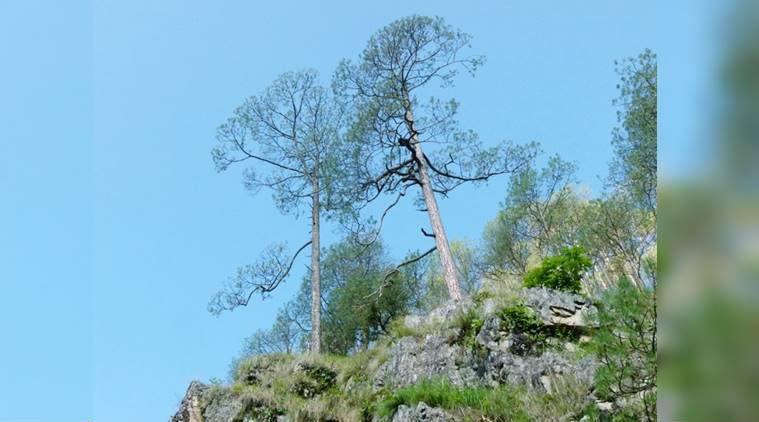Down in Jungleland: Death of a Tree
The munificence of trees is lost on a people bent on destroying the very thing that gives them life. It’s not as if nature makes life easy for trees. A tiny undigested seed may be deposited in a dung heap by an animal that has just munched a delicious fruit.
 Under my shade: The trees around us give entire ecosystems their life-force. (Source: Ranjit Lal)
Under my shade: The trees around us give entire ecosystems their life-force. (Source: Ranjit Lal)
Trees and green plants are surely among one of Mother Nature’s most fanciful concepts. On the one hand, you have every living creature on earth, breathing in oxygen and exhaling carbon dioxide. And, on the other, you have trees and their ilk, taking in that same carbon dioxide and emitting oxygen to keep the world alive. How neat is that?
It’s not as if nature makes life easy for trees. A tiny — maybe not so tiny — undigested seed may be deposited in a dung heap by an animal that has just munched a delicious fruit. So, it’s already down in the dumps. But this dump is full of natural goodness: It enables the seed to drill a root into the ground and send a shoot skywards — both with different missions. The root seeks out water and more mineral nutrients. The shoot shyly branches out and unfurls its miracle workers: green leaves. They are equipped with the wonderful green pigment, chlorophyll, which acts like a catalyst in collusion with the photons sent out by the sun: it splits up water (H2O) molecules drawn up from the roots into hydrogen and oxygen, letting the oxygen dissipate into the atmosphere, without which all life would be impossible. The hydrogen it combines with the carbon dioxide, and with some additional complex chemical jugglery produces carbohydrates, sugars and then fats. Add a little nitrogen in the mix, and proteins will be formed, and, with the addition of a few other chemicals, the building blocks of living tissue come into being. Any extra water is dissipated into the air in the form of vapour.
But from day one, it appears that every living creature out there is out to take the young (and, later, not-so-young) tree down — the roots are set upon by gnawing rodents, insects and fungal infections. Above ground an army of insects and herbivores attack the tender green leaves and shoots. For a tree, elephants, goats and, of course, human beings are vicious predators. Caterpillars defoliate them on the scale of Agent Orange in Vietnam. So much so, that many young leaves are not green when they first unfurl, but red and yellow — and are filled with poisons and tannins to keep greedy predators at bay. Some trees and plants (like tobacco) emit warning chemicals into the air to warn others downwind of approaching danger, so that they can quickly “weaponise” before being attacked. Others emit scents that attract animals which prey on their predators (my enemy’s enemy is my friend). Some arm their leaves with prickles, thorns and hypodermic-like needles, loaded with venom. Then there’s competition — other trees. All reaching for the sky to spread their canopy as wide as possible to catch the maximum sunlight. Some trees will kill for this by smothering their rivals! Others are more devious. Parasitic vines and creepers throttle the life out of full grown trees as effectively as a python asphyxiating a rat, sucking out the nutrients traveling up and down the trees trunks.
Beetles bore into tree trunks to lay their eggs there — some of their (hideous) grubs can digest even tough cellulose. The bark is the most important part of the tree trunk which protects and even nourishes the tree — elephants casually strip large swathes of bark off the trunk, ensuring their slow death (if they don’t simply “mercy kill” them by knocking them over).
Of course, the trees fight back. One way to ensure survival is to have millions of babies! So trees lure greedy animals, birds and insects to help pollinate their flowers and scatter vast numbers of seeds around. Some use the wind for this purpose — their seeds may be attached to appendages resembling gliders, helicopters and parachutes. Some produce a lesser number of — but very large and hardy — seeds, which can survive lying around (or traveling), for a long time: coconuts are often sent off to sea and encouraged to find beaches far away from home!
When fully grown, a tree supports an entire ecosystem on its own, even helping expedite the process of rainfall! But to these miracle machines, we shamelessly take our power-saws en masse. Several years ago, I received a three-line short story written by a little boy: Once there was a lion. He ate everyone up Then he ate himself up.
That can now be rewritten as:
Once there were trees,
We chopped them all down
Then we chopped ourselves down.



- 01
- 02
- 03
- 04
- 05




























